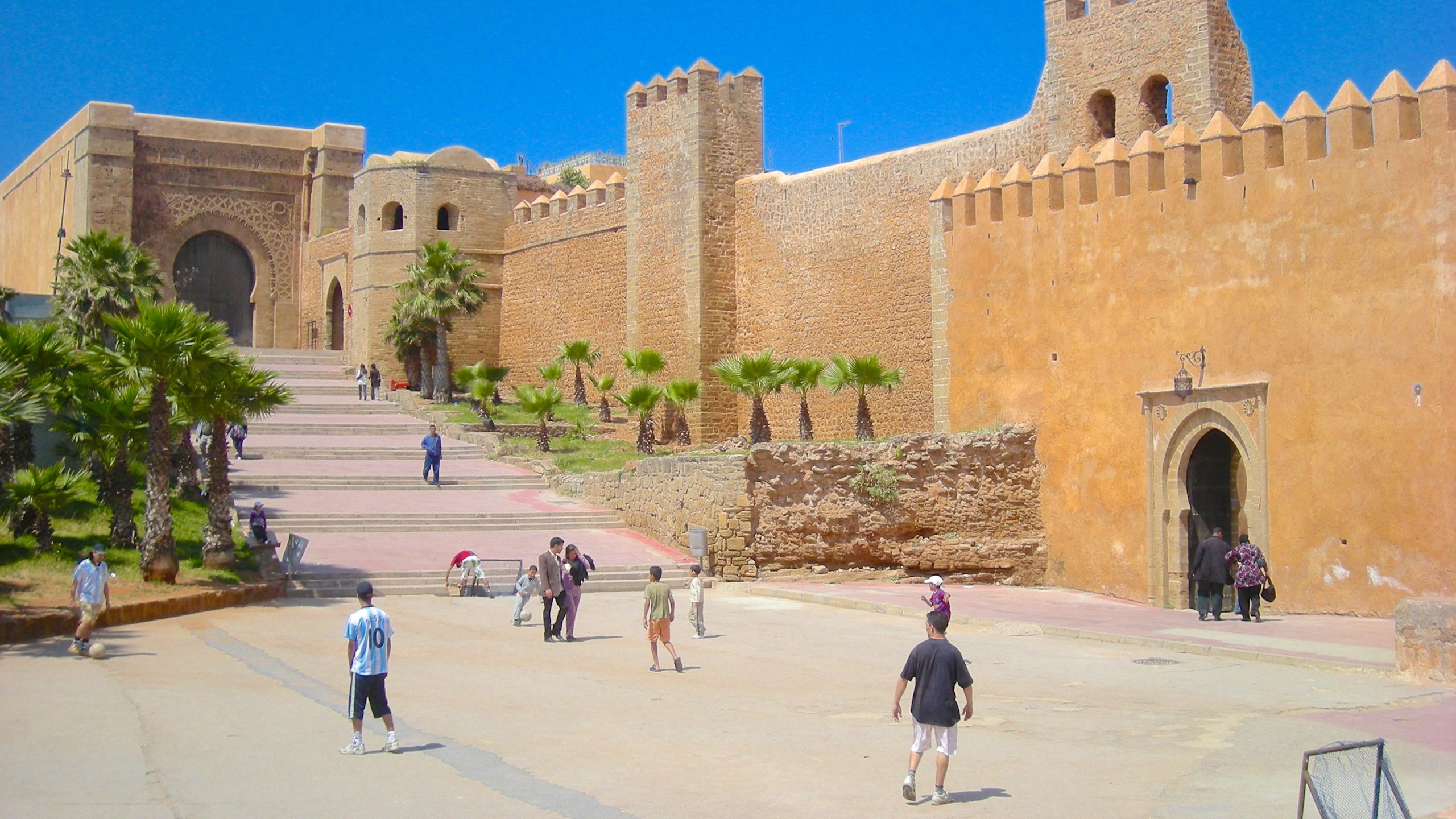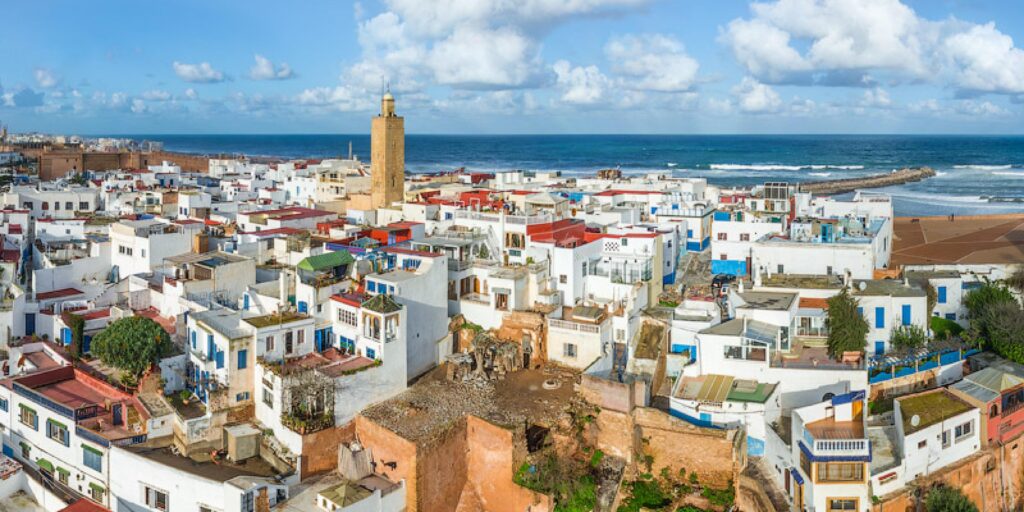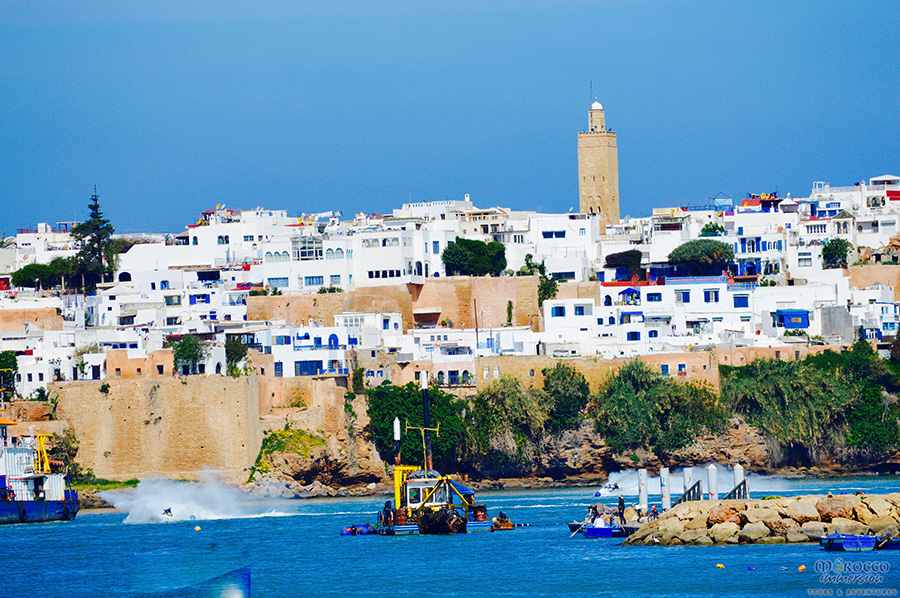Rabat – Morocco’s Attractive and Romantic Capital

By: Habeeb Salloum/Arab America Contributing Writer
We had toured three of Morocco’s spectacular Imperial cities, Fez, Meknes, and Marrakesh, and now we were in the fourth, Rabat, the country’s present-day capital. For near a month we had been excited and enthralled in these ancient towns by their many historic buildings, smothered with Andalusian-Moorish architecture. We had reveled in their breathtaking tiled walls, unbelievable superb Arabic calligraphy, exquisite courtyards, and delicate fountains. Amid these remnants of Muslim Spain, brought to North Africa by the expelled Arabs from the Iberian Peninsula, we had discovered a world of unforgettable beauty. The only clouds which marred our visits were the litter, strewn along a good number of roads and avenues, beggars and the pestering young men who wanted to sell us trinkets or act as would-be guides.
At this, our last stop before leaving Morocco, we found the same ancient monuments, but they were surrounded by clean white avenues, flowering gardens and stately whitewashed mansions. The harassing young men and beggars were nowhere in sight. It was an elegant and serene modern capital which well merited its label ‘the first jewel in the Moroccan crown’.
A national showplace, Rabat is a spacious city with wide expanses of greenery encircling splendid modern structures. These edge historic ramparts which hug ancient quarters, creating a city of fascinating duality. The administrative and intellectual center of the country, it hums with life. Yet, with little industry, it does not have the pollution and smog of other cities. In it are found the provincial charms of calmness, orderliness, and dignity. A traveler, impressed with its atmosphere of beauty and neatness, once wrote: “Nothing is ugly in Rabat, not even its railway station”.
Originally, Rabat was the Roman town of Sala Colonia whose ruins are encompassed by present-day Chellah on the outskirts of the city. Subsequently, Sala was forgotten until the 11th century when the first Almohade Sultan, Abd al-Mu’min, built a ribat (fortified camp) – today a part of the Oudaias Quarter. His grandson, Yaqoub al-Mansour, whose empire included all North Africa and Muslim Spain, turned the ribat into his capital. After his armies in 1195 defeated the Spanish Christians at Alarcos, he enlarged the town and named it ribat al-fath (Camp of Victory), later shortened to Rabat. The most important of today’s monuments found in the city date from his era.
In the ensuing centuries the capital was transferred elsewhere, and Rabat declined. It was revived somewhat by the thousands of Arabs expelled from Spain. For a while, these Spanish Muslims established in Rabat and its twin city Salé their own tiny kingdom from which they raided their former homeland. Later, it was reincorporated back into Morocco. However, the city’s former splendour did not return until 1912 when the French made it capital of the country.

For those interested in the city’s past, the most important of Rabat’s monuments is the impressive 44 m (144 ft) high Tour Hassan which is part of a never-completed ruined mosque, intended to be the largest in North Africa. It’s eight-foot-thick walls, each decorated differently on the outside, makes this unfinished minaret a sturdy and attractive landmark which dominates the city. The ruins of its attached mosque include parts of 200 columns, some renovated and surrounded by a newly laid concrete slab floor.
At the end of these columns rises a white marble terrace on which stands the Mausoleum of the former King Mohammed V, the beloved father of Moroccan independence, edged by small mosque and museum. The entire complex is an exquisite example of modern Andalusian-Moorish architecture and the most popular tourist site in Rabat. A splendid creation of Moroccan craftsmen only surpassed by the new Hassan II Mosque in Casablanca it is a living testimony that the architecture developed by the Arabs in Spain is alive and doing well in Morocco.
Other not-to-be-missed remains from the bygone ages are the dead town of Chellah which became the necropolis for the notables of the 13th to 15th century Merinid Dyansty; the Kasbah des Oudaias, built on a rocky rise overlooking the Atlantic, encompassing an Andalusian garden and encircled by striking ramparts; and the Medina (old city), still ringed by its ancient walls, where traditional handmade goods intermixed with the products of the 21st century are sold.
These testimonials to the past are complemented by the magnificent royal residence, a sprawling complex and villas with their superb courtyards and eye-catching green roofs topping yellowish-white walls; the Essouna Grand Mosque, noted for its striking brownish minaret; and Avenue Mohammed V with its cafes, flowerbeds, fountains and Andalusian-Moorish style public buildings and shops.

After touring these landmarks in Morocco’s capital, a visitor can rest a while in one of Rabat’s new hotels and sip mint tea in their Andalusian-Moorish decorated salons, then, perhaps, play a little golf at the Royal Dar Es-Salam Gold Club – one of the most magnificent in the world. If one would rather romp in the sea, to the north is Plage des Nations, the top seaside playground near the city; and to the South: Temera, Sehb ed-Dheb, Eech Chiahna and Skhirat beaches.
The best time to visit Rabat is between April and October. During this time of the year, the flowers are in full bloom, the sea is warm, and all sport facilities are open. Every evening during these months, the inhabitants parade throughout the city decked in a kaleidoscope of colours in their Moroccan finery. Perhaps, in the whole world there is no greater diversity of attired men in this North African country. Riding the buses and trains, walking the streets, and visiting homes of friends, I have never ceased to be amazed by the endless types of clothing worn by both men and women. In the mild Rabat months, the masses of humanity moving along the streets reflect this medley of styles and colors.
This nightly picturesque promenade scene, the remains of the bygone splendors and its numerous modern attributes make Rabat an Imperial city of many faces and a tourist destination par excellence. Here they will find the romantic fantasy of Arab Spain, fantastic relics from the past and enchanting contemporary flowering gardens, villas, palaces, and lodging places.


